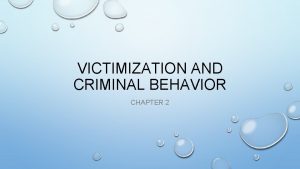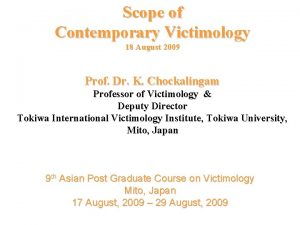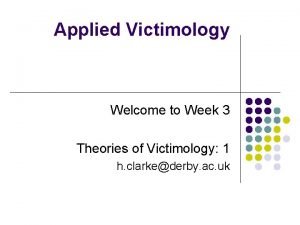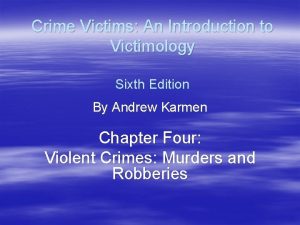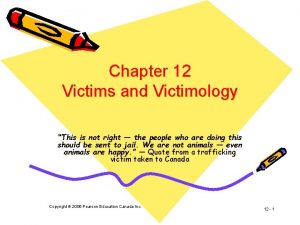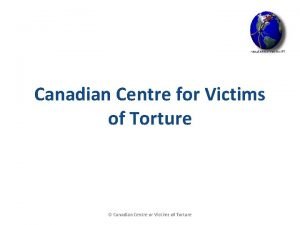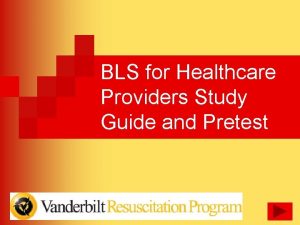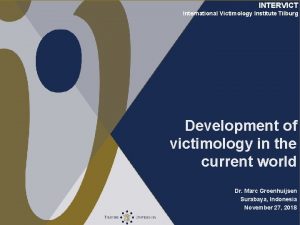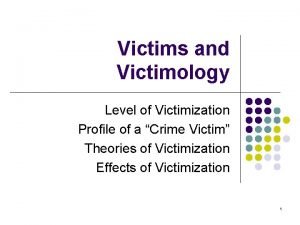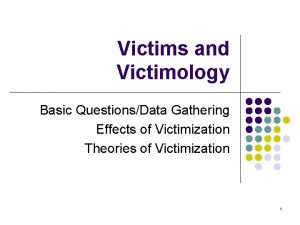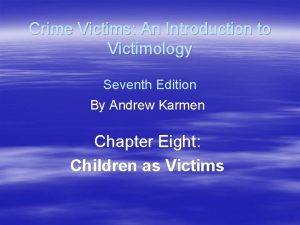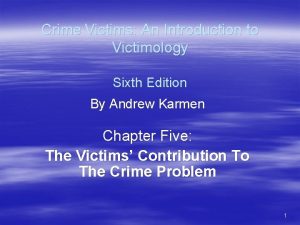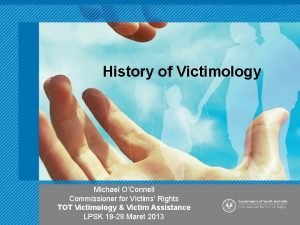Chapter 12 Victims and Victimology This is not

















- Slides: 17

Chapter 12 Victims and Victimology “This is not right — the people who are doing this should be sent to jail. We are not animals — even animals are happy. ” — Quote from a trafficking victim taken to Canada Copyright © 2006 Pearson Education Canada Inc. 12 - 1

Learning Objectives • Understand the role of victimology within the criminological area. • Identify and describe the key theories of victimology. • Identify some of the key findings regarding victims of crime. • Understand discuss the new challenges and direction of victimology. • Recognize and identify the range of government services for victims. Copyright © 2006 Pearson Education Canada Inc. 2

Overview • “crime, for the most part, is injury inflicted on another person” von Hentig, 1948: 383 • What it is: – the study of the victim or victims of a particular offender. – an analysis of victim characteristics – "victim profiling" (Holmes & Holmes ‘ 96) • Why study victims? – Traditionally been neglected – ‘one of the most beneficial tools in classifying and solving a violent crime’ (Douglas et al. , ’ 92) Copyright © 2006 Pearson Education Canada Inc. 3

• ROOTS OF VICTIMOLOGY: • Benjamin Mendelsohn (1900 -1998) - Victimology should be part of criminology - Hans von Hentig (1887 -1974) - The Criminal and His Victim - Classified victims according to personality - Importance of subject-object relations - Case studies: - Reena Virk - ‘Fred’ Shipman - Holly Jones - ’ 70 s and ’ 80 s ‘art of blaming the victim’ - Role of political and ideological climate Copyright © 2006 Pearson Education Canada Inc. 4

• Victimology: – Emerged as an applied discipline – 1 st symposium 1973 • Key conclusions • 10 th symposium Montreal – ‘ 50 s and ‘ 60 s – dramatic change – ‘ 80 s and ’ 90 s - consolidation & theorizing – UN Declaration of Basic Principles of Justice for Victims of Crime and Abuse of Power – ’ 85 1. www. unhchr. ch/html/menu 3/b/h_comp 49. htm Copyright © 2006 Pearson Education Canada Inc. 5

History of Victimization Surveys • Original objective to count the ‘dark figure’ of crime • Originally NOT concerned with victims • Inadequacy of official statistics as crime indicator • Provide estimate of hidden victimization Copyright © 2006 Pearson Education Canada Inc. 6

Victimization Surveys • Provide information on the aftermath of their victimization • Allows researcher to assess the CJS response to victims • Surveys enable researchers to gauge public attitudes towards the CJS • Enables the researcher to measure levels of fear of crime • Enables the researcher to tap into the number of victims who do not report their victimization Copyright © 2006 Pearson Education Canada Inc. 7

Advantages and Disadvantages VS • Extend and distribution of selected crimes • Measure impact of selected crimes • Assess risk of victimization • Assess victim’s perception on the functioning & effectiveness – CJS • Caution: • Return on time and money • Possible backlash • standardization Copyright © 2006 Pearson Education Canada Inc. 8

Different Major Surveys • CUVS ’ 80 s – Telephone: 60 000 – 8 categories of crime • GSS ’ 88 – Standardized and consistent format – Box 12. 2 • VAWS ’ 93 – Women… 2001, ’ 02 Family Violence in Canada: A Statistical Profile • ICVS (Jan Van Dijk 1947 - (Box 12. 5) – 1989, 1992, 166, 2000, 2004 Copyright © 2006 Pearson Education Canada Inc. 9

Victim Characteristics • Social and demographic details… • Age: – youth vs. elderly • Gender: – Differences in risk by type of crime • Social status: – Economic strata and crime prone areas • Marital status: – Lifestyle matters • Race and ethnicity: – Controversial and politically charged • Repeat victimization: – Predisposition, propensity, proneness & vulnerability Copyright © 2006 Pearson Education Canada Inc. 10

Theoretical models • Victim precipitation theory: – Von Hentig – actions are the telltale – Stereotype and typologies – Work of Henri Ellenberger • Lifestyle Model: – Significance of one’s lifestyle • More active & More social = RISK! – Contrast with opportunity theory – 3 related hypothesis Copyright © 2006 Pearson Education Canada Inc. 11

• Routine Activities Theory: – Opportunity or suitable targets – Lack of capable guardians/protectors – Motivated offender • Integrated Theory Victimization – Opportunities to association to hi-risk activities… structural/cultural proneness – ! Too many factors Copyright © 2006 Pearson Education Canada Inc. 12

The Emergence of Victims’ Rights • 1985 UN Declaration of Basic Principles of Justice for Victims of Crime and Abuse of Power • www. unhchr. ch/html/menu 3/b/h_comp 49. htm • 2003 CDN Statement of Basic Principles of Justice for Victims of Crime • Victim Impact Statements (VIS): – Right to have his/her impressions re the offence read/heard in court – 1988 CDN legislation (see Box 12. 6) – 1995 standardized the process – A voluntary option Copyright © 2006 Pearson Education Canada Inc. 13

• Victim Assistance Programs: – Victim compensation – controversial – 1988 victim fine surcharge – Provincial exception – Court Services – Assist victims while attending court and in dealing with the CJS – Victim Service Programs – Diverse and widespread – Public Education – Usually associated with legal and/or CJ organization – Varying degrees of ‘success’ Copyright © 2006 Pearson Education Canada Inc. 14

• Crisis Intervention – Victims experience an array of difficulties/challenges – Facilitate the healing process • Empathy, understanding & validation • Victim-Offender reconciliation programs (VORP) – Restorative justice movement – Mennonite and First Nations – Volunteer based • Evaluation of Victim Assistance Programs – – – Mixed results Accessibility Truly meeting victims’ needs Restorative justice model Possible extension of state control Copyright © 2006 Pearson Education Canada Inc. 15

New Directions in Victimology • Constantly evolving • Fattah ’ 97: – Alternative healing practices – Role of restorative justice model – Bridging barriers between criminal and civil courts • A major factor in a criminal event • Improve UCR data • Increasing presence in criminology & criminal justice Copyright © 2006 Pearson Education Canada Inc. 16

SUMMARY • Victimology a major focus • Risk related to: age, gender, SES and setting, and lifestyle • Key theories include: precipitation theory, lifestyle model, & RAT • Increasingly bridging theory and practice: – Impact statement, public education, & VORP – Victim’s right and restorative justice • Victim no longer the forgotten factor in the criminal event Copyright © 2006 Pearson Education Canada Inc. 17
 Human behavior and victimology
Human behavior and victimology Scsi unit fbi
Scsi unit fbi Stephen schafer victimology
Stephen schafer victimology Mendelsohn's theory of victimization
Mendelsohn's theory of victimization Differential risk victimology
Differential risk victimology Benjamin mendelsohn victimology
Benjamin mendelsohn victimology Makalah green victimology
Makalah green victimology Victimology in criminology
Victimology in criminology Shared responsibility victimology
Shared responsibility victimology English 9 vocabulary unit 1
English 9 vocabulary unit 1 West memphis 3 crime scene photos
West memphis 3 crime scene photos Charlene gallego victims
Charlene gallego victims Marybeth roe tinning
Marybeth roe tinning Canadian centre for victims of torture
Canadian centre for victims of torture Word formation fashion
Word formation fashion Religious beliefs about helping victims of war
Religious beliefs about helping victims of war Hammock carry - three man carries
Hammock carry - three man carries After positioning yourself directly above the victims head
After positioning yourself directly above the victims head
